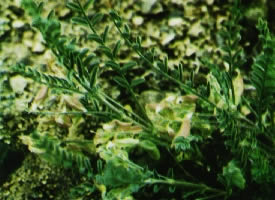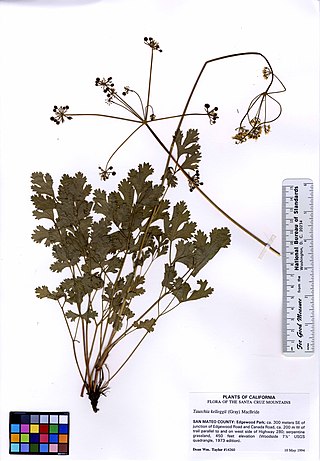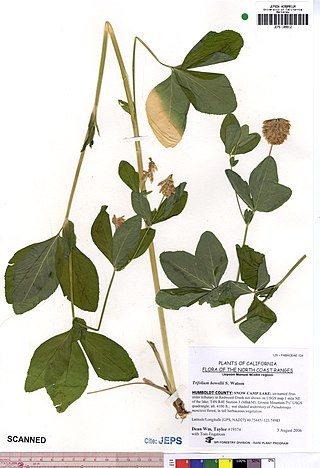
Antennaria howellii is a North American species in the genus Antennaria within the family Asteraceae. It is native to northern Alaska, much of Canada including the Arctic territories, and the northern United States as far south as northern California, Colorado and North Carolina.

Thelypodium howellii, the Howell's thelypody or Howell's thelypodium, is a rare plant of the Western United States. It is endemic to a relatively small area on the borders of three western States: Oregon, Nevada, and California.

Tauschia is a genus of flowering plants in the carrot family which are known as umbrellaworts. These are perennial plants with taproots or tubers and foliage generally resembling that of relatives parsley and carrot. Tauschia are native to the Americas.

Aconitum columbianum is a species of flowering plant in the buttercup family known by the common names Columbian monkshood or western monkshood.

Allium howellii is a North American species of wild onion known by the common name Howell's onion. It is endemic to California.

Astragalus johannis-howellii is a species of milkvetch known by the common name Long Valley milkvetch. It is native to eastern California, including Long Valley in Mono County, and its distribution extends over the border into Nevada. It is a plant of the Great Basin's scrub habitat.
Chorizanthe howellii is a species of flowering plant in the buckwheat family known by the common names Mendocino spineflower and Howell's spineflower. It is endemic to coastal Mendocino County, California, where it is known only from the sand dunes and coastal scrub near Fort Bragg. It is estimated that 95% of the remaining individuals of this plant are part of a single population growing at MacKerricher State Park. It is a federally listed endangered species.
Draba howellii is a species of flowering plant in the family Brassicaceae known by the common names rosette draba and Howell's draba. It is endemic to the Klamath Mountains of northern California and southern Oregon, where it grows in rock crevices. This is a tuft-forming perennial herb, sometimes coated in hairs. Most of the leaves are located at the base of the plant, each oval in shape, up to 2.5 centimeters long, and sometimes edged in fine teeth. There may be one or more leaves on the stem as well. The erect inflorescence bears up to 30 yellow mustardlike flowers. The fruit is an oval silique up to a centimeter long containing several seeds.

Lomatium howellii is an uncommon species of flowering plant in the carrot family known by the common name Howell's biscuitroot, or Howell's lomatium. It is native to the Klamath Mountains of southern Oregon and northern California, where it is a member of the local serpentine soils flora.
Minuartia howellii is an uncommon species of flowering plant in the family Caryophyllaceae known by the common names Howell's stitchwort and Howell's sandwort.
Pedicularis howellii is an uncommon species of flowering plant in the family Orobanchaceae known by the common name Howell's lousewort. It is endemic to the Siskiyou Mountains of the Klamath Range in southern Oregon and northern California, where it grows on the edges of coniferous forests. This is a perennial herb producing one or more stems up to 45 centimetres (18 in) tall from a long caudex. The leaves are up to 20 centimetres (8 in) long, lance-shaped, and divided into many toothed oval lobes; those higher on the stem may be unlobed. The basal leaves fall away early. The inflorescence is a small raceme of flowers occupying the top of the stem. Each white to light purple flower is up to one centimetre long and is sickle-shaped, with a curved beak-like upper lip and a three-lobed lower lip which may be tucked into the hairy mass of sepals. The plant is pollinated by bumblebees including Bombus mixtus. Between the flowers are hairy to woolly triangular bracts. The fruit is a capsule just under a centimeter long containing seeds with netted surfaces.
Perideridia howellii is a species of flowering plant in the family Apiaceae known by the common name Howell's yampah. It is native to the mountains of Oregon and northern California, where it grows in moist soils, often near streams and rivers. It is a perennial herb which may exceed 1.5 metres in maximum height, its slender, erect stem growing from a cluster of many narrow fibrous roots measuring up to 15 centimetres long. Leaves near the base of the plant have lance-shaped blades up to half a metre long which are divided into many leaflets made up of toothed, oval segments. Leaves higher on the plant are similar, but generally smaller. The inflorescence is a compound umbel of many spherical clusters of small white flowers. These yield ribbed, oblong-shaped fruits each about half a centimetre long.
Puccinellia howellii is a rare species of grass known by the common name Howell's alkaligrass. It is endemic to Shasta County, California, where it is known from a single population in Whiskeytown National Recreation Area near Whiskeytown. Its entire population is contained in a 1-acre (4,000 m2) complex of three saline mineral springs directly next to Highway 299. The grass was first described to science in 1990 and no other populations were discovered despite extensive searches of the area.
Streptanthus howellii is an uncommon species of flowering plant in the mustard family known by the common name Howell's jewelflower. It is endemic to the Klamath Mountains of southern Oregon and northern California. It grows in mountain forests on serpentine soils. It is a perennial herb producing a hairless, often waxy-textured stem up to 70 or 80 centimeters in maximum length. It is generally unbranched. The ephemeral basal leaves have fleshy oval blades with smooth or toothed edges, borne on petioles. Leaves farther up the stem are similar but smaller and narrower, with shorter petioles or none. They do not clasp the stem. Flowers occur at intervals along the upper stem. Each has a calyx of purple sepals under a centimeter long with purple-tipped yellow petals emerging from the tip. The fruit is a thin, smooth, curved silique up to 12 centimeters long.

Tauschia arguta is a species of flowering plant in the carrot family known by the common name southern umbrellawort. It is native to the mountains of southern California and Baja California, where it grows in local habitat types such as woodlands and chaparral.

Tauschia kelloggii is a species of flowering plant in the carrot family known by the common name Kellogg's umbrellawort. It is native to the mountains of Oregon and the northern half of California, where it grows in chaparral, woodlands, forest, and other types of habitat. It is a perennial herb growing up to 70 centimeters tall. The leaves have blades which are divided into toothed or serrated leaflets, and sometimes subdivided further. The inflorescence is a compound umbel of yellow flowers with 10 to 20 rays measuring 2 to 12 centimeters long each. The fruit is somewhat rounded in shape, ribbed, and up to half a centimeter long.
Tauschia parishii is a species of flowering plant in the carrot family known by the common name Parish's umbrellawort. It is endemic to California.

Trifolium howellii is a species of clover known by the common names canyon clover and Howell's clover. It is native to Oregon and California, where it grows in moist and shady habitat types, such as swamps and forest streambanks.
Erythronium howellii, or Howell's fawn lily, is a flowering bulb in the lily family endemic to northwestern California and southwestern Oregon.
Grindelia howellii, or Howell's gumweed, is a North American species of flowering plants in the family Asteraceae. It is native to the northwestern United States, in the States of Idaho and Montana.










